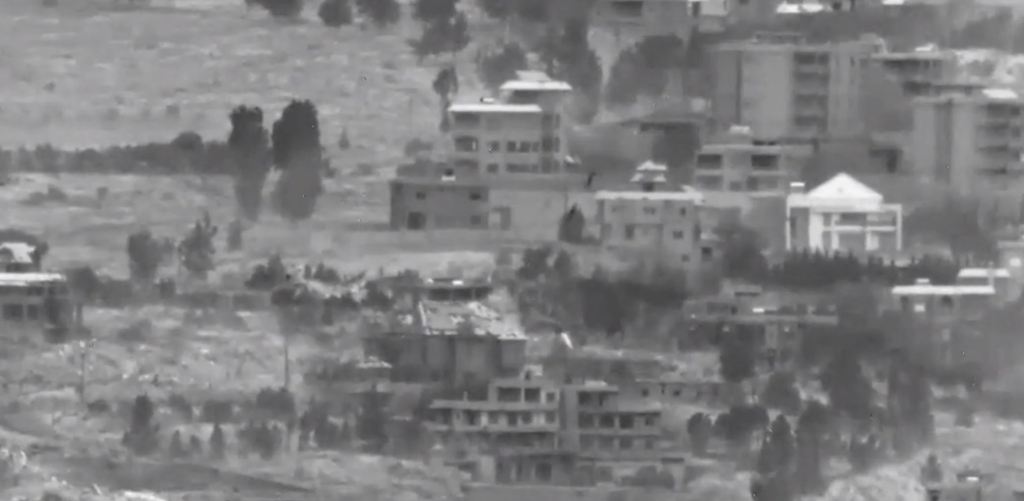
On April 16, Hezbollah launched two drones that crossed into Israel and struck near the community of Beit Hillel in the Huleh valley two miles from the Lebanese border. The pro-Iranian Al-Mayadeen media claimed that Hezbollah had targeted an Israeli Iron Dome air defense battery. Two armed UAVs crossed from Lebanon into Israeli territory and exploded in the area of Beit Hillel. “The incident is under review,” the IDF said.
The drone attack appeared to involve a drone modelled after the Iranian Ababil drone family, which has also appeared in use by Iranian-backed groups in Iraq, and by the Houthis and terrorists in Gaza. The drone has a long fuselage packed with explosives, a small motor and rotor at the rear that makes a loud sound like a lawnmower, and two sets of small wings. The same type of drone was used by Hezbollah in an attack on April 17 targeting the border community of Arab al-Aramshe. Aab al-Aramshe sits on the Lebanese border, with its homes within shouting distance of the border itself. It is exposed and vulnerable.
Israel evacuated most northern communities near the border in October, removing around 80,000 people due to the Hezbollah attacks. Most of the non-Jewish communities along the border did not evacuate, such as Druze in Hurfeish, Arabs in Fassuta, or the beduin Arab community of Arab al-Aramshe. The lack of evacuation is clear from the videos of the April 17 attack, in which residents used cameras to watch the drone slam into a local community center, where six people were wounded, two of them seriously. Hezbollah claimed it targeted an IDF reconnaissance company unit in the village.
The attack follows a series of escalations in northern Israel. Hezbollah supported the Iranian attack on Israel on the evening of April 13-14 by firing more than 150 projectiles at IDF bases in the Golan. The group then wounded several IDF Golani troops on April 15 in what Hezbollah claimed was an ambush using an explosive device. “Overnight, during IDF activity in the area of the northern border, an IDF soldier was severely injured, two IDF soldiers were moderately injured, and an additional IDF soldier was lightly injured, as a result of an explosion of an unknown source. The incident is under review,” the IDF said.
The IDF responded to the escalation on April 15 striking “a number of military structures in a complex belonging to Hezbollah’s Radwan Forces in the area of Jbaa in southern Lebanon,” the IDF said. The IDF followed up by hitting a Hezbollah weapons manufacturing site in the area of Nabi Chit. The site is around 30 miles north of the Israeli border in the Bekaa valley.
Hezbollah said it responded on April 17, targeting the headquarters of the IDF’s 91st division in Biranit near the border. Hezbollah claimed it used the heavy Burkan rocket to target the base. It also said it attacked another base of an IDF unit responsible for protecting the border. The 91st is the division responsible for the Lebanese border. Hezbollah also claimed to target an IDF site on Mount Meron. The Iranian-backed group has targeted these sites before, trying to show it can conduct precision strikes on IDF facilities.
On April 16 Israel targeted Ismail Yusaf Baz who the IDF said was “the commander of Hezbollah’s coastal sector, in the area of Ain Ebel in Lebanon.” He was a senior Hezbollah member involved in the promotion and planning of rocket and anti-tank missile launches toward Israel from the coastal area of Lebanon.” Then the IDF also struck Muhammad Hussein Mustafa Shechory, who it said was “the Commander of the Rockets and Missiles Unit of Hezbollah’s Radwan Forces in Lebanon’s central and western region.”
The IDF responded through the two days of escalation. The IDF targeted a Hezbollah official in Kfar Dounine, and conducted strikes against Hezbollah compounds and sites in Seddiqine, Matmoura, Labbouneh, Kfarkela, Maroun El Ras, Markaba, Matmoura, Majdal Zoun, Souaneh, Jabal Blat, Hamra, Meiss El Jabal, Tayr Harfa, Chebaa, Ain Baal, Aalma El Chaeb, Hanine, Yaroun, Khiam, Mansouri, Aalma El Chaeb, Yater and Ayta ash Shab in southern Lebanon.







